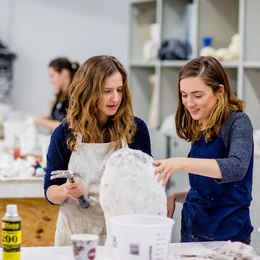
The Pennsylvania Academy of the Fine Arts has been a pillar of studio arts education for more than 200 years. Yet, few know that PAFA and another local academic institution, the University of Pennsylvania, have been partnering to offer a liberal arts/studio arts joint degree program for nearly a century.
“We’re the oldest art school and museum in the country, founded in 1805, so we have that historical importance,” says Anne Stassen, PAFA’s dean of students. “We’re one of the only schools in the country devoted exclusively to fine arts.”
The combination of PAFA’s storied history and Penn’s renowned liberal arts education creates a “best of both worlds” interdisciplinary program that no other art school can match, according to Stassen.
“[The program] gives students access to the best studio art instruction and criticism and gives them some of the best liberal arts academics,” she says. “Students have options to take a full range of classes they are interested in; they can design their own experience going through.”
That experience includes traditional approaches to art making, with the latest high-tech facilities—from stone carving to digital illustration labs, and everything in between.
There are three distinct courses of undergraduate study at PAFA, explains Dean of the School of Fine Arts Clint Jukkala. There is the in-house PAFA Bachelor of Fine Arts degree and a four-year Certificate program, which features purely studio-based studies.
Then there is what many at PAFA refer to as the school’s best-kept secret: the joint program between PAFA and Penn, wherein students receive liberal arts education at Penn and train in the studio arts at PAFA, ultimately earning a B.F.A. degree from Penn.
In all of PAFA’s degree programs, students gain mastery in foundational skills and explore their own passions in their individual on-campus studios. Hallmarks of a PAFA education are an intensive first-year experience focused on perception and the act of seeing, as well as hands-on work that includes sculpture, printmaking and drawing from models, as well as the historic casts of classical sculptures in the breathtaking Cast Hall.
All the while, students have access to PAFA’s world-renowned museum collection of American art and contemporary exhibitions. As they move through the curriculum, students further their artistic development through independent studio work, and their experience culminates in a capstone exhibition in PAFA’s museum that draws crowds of art collectors and gallery owners.
The PAFA/Penn B.F.A. degree program uniquely combines all of those elements with an Ivy League liberal arts education, allowing students to pursue their passion for art alongside their personal intellectual interests.
Jukkala calls the program “a tremendous opportunity for students who want to focus in studio art and think about the ways that their studio art might combine with liberal arts training to advance their careers.”
The dual nature of the program provides an almost endless array of options. One student interested in art therapy might take psychology classes at Penn, while another considering a graduate degree may enroll in art history courses, and another simply looking to improve their communication skills could take writing classes.
“The important point is the flexibility of it and that students can really make it work for their needs and what they most want to focus on,” Jukkala says.
A student who exemplifies the utility of the connection between the liberal and studio arts is Brittany Bennett, who is currently in her last year of studies at Penn. Bennett always knew she wanted to pursue a career in scientific illustration.
“The coordinated degree program was a great fit for me because it allowed me to develop my technical drawing and painting skills at PAFA, while also taking biology and chemistry courses at Penn,” she says. “With my biology minor, I am at an advantage for applying to jobs, internships and graduate programs in scientific illustration because not only can I draw, but I can understand the science of what I’m drawing.”
PAFA, for example, provided the opportunity to learn anatomy by drawing live animals, including horses and hawks brought right to the school; at Penn, Bennett used for artistic endeavors the same 3-D anatomical software utilized by Penn Medicine students.
“I was surprised by how much my studio practice was inspired by my academic studies,” she says. “The major work of my final year at PAFA ended up being deeply informed by anatomy, historical medicine, medical imaging, gender studies and religious iconography—all topics that I explored in my various classes at Penn.”
Bennett says she would recommend the program to students who enjoy the balance between academics and art—“people who enjoy a challenge, have an artistic sensibility and are passionate about art but also crave rigorous academics—students who can use what they’re learning academically to make more provocative or mature art at PAFA.”
The PAFA/Penn B.F.A. program is not, Bennett observes, for those who do not appreciate a challenge.
“However,” she says, “with the rigor comes a top-notch education, great opportunities, a diverse community and maybe even the inspiration for your next magnum opus.”
Pennsylvania Academy of the Fine Arts
118-128 N. Broad Street
Philadelphia, PA 19102
215-972-7600
www.pafa.edu/pennbfa
Photograph courtesy of PAFA


